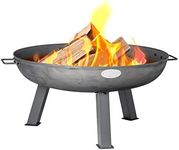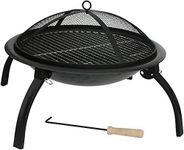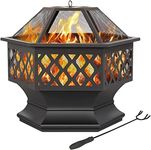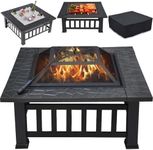Buying Guide for the Best Outdoor Fire Pits
Choosing the right outdoor fire pit can enhance your outdoor living space, providing warmth, ambiance, and a focal point for gatherings. When selecting a fire pit, consider the size of your space, the type of fuel you prefer, and the style that complements your outdoor decor. It's important to think about how you plan to use the fire pit, whether for cooking, heating, or simply as a decorative element. Understanding the key specifications will help you make an informed decision that suits your needs and lifestyle.Fuel TypeThe fuel type of a fire pit determines how it operates and the kind of maintenance it requires. Common fuel types include wood, propane, and natural gas. Wood-burning fire pits offer a traditional experience with crackling sounds and a smoky aroma, but they require more effort to start and clean. Propane and natural gas fire pits are easier to ignite and control, providing a cleaner burn with less smoke. Consider how much effort you're willing to put into maintaining the fire pit and whether you have access to a gas line or prefer the convenience of propane tanks.
MaterialThe material of a fire pit affects its durability, appearance, and maintenance needs. Common materials include steel, cast iron, stone, and copper. Steel is lightweight and often coated to resist rust, making it a popular choice for portability. Cast iron is heavier and retains heat well, but it can rust if not properly maintained. Stone fire pits are durable and blend well with natural surroundings, while copper offers a unique aesthetic that develops a patina over time. Choose a material that matches your style preferences and the level of maintenance you're comfortable with.
Size and ShapeThe size and shape of a fire pit should complement your outdoor space and meet your usage needs. Fire pits come in various shapes, such as round, square, and rectangular, each offering different seating arrangements and aesthetic appeal. Consider the size of your outdoor area and how many people you want to accommodate around the fire pit. A larger fire pit is suitable for bigger gatherings, while a smaller one is ideal for intimate settings. Ensure there's enough space around the fire pit for safety and comfortable seating.
Heat OutputHeat output, measured in BTUs (British Thermal Units), indicates how much warmth a fire pit can provide. Higher BTUs mean more heat, which is important for cooler climates or larger spaces. For a cozy ambiance in a small area, a fire pit with lower BTUs may suffice. Consider the climate of your location and how you plan to use the fire pit. If you want it primarily for warmth, opt for a higher BTU model. If it's more for ambiance, a lower BTU might be adequate.
Safety FeaturesSafety features in a fire pit are crucial to prevent accidents and ensure safe operation. Look for features like spark screens, which prevent embers from escaping, and safety shut-off valves for gas models. Some fire pits also have heat-resistant coatings or materials to prevent burns. Consider who will be using the fire pit, especially if children or pets are around, and choose a model with appropriate safety features to minimize risks.
















